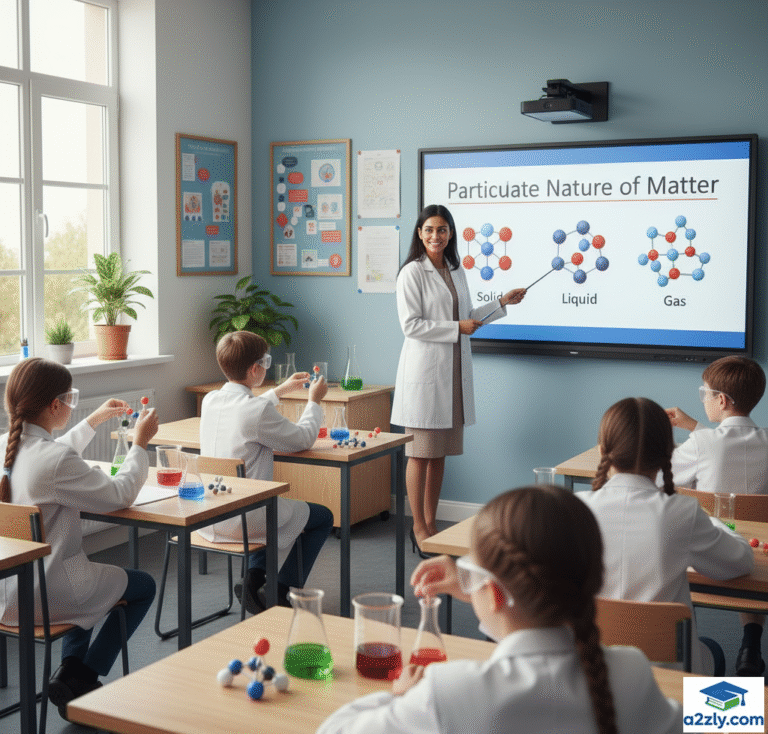🧭 Chapter Overview – Particulate Nature of Matter
The chapter “Particulate Nature of Matter” explores the fundamental concept that all matter—everything around us—is made up of extremely small particles. These particles are invisible to the naked eye but are the building blocks of all substances. Through interesting classroom activities and real-life examples, students learn how the behavior, spacing, and motion of these particles determine the three physical states of matter—solids, liquids, and gases.
This chapter also introduces ancient ideas like Acharya Kanad’s Parmanu theory, and modern explanations involving interparticle attraction and thermal energy. Learners understand how changes in heat can cause changes in state—from solid to liquid and liquid to gas—and how the properties of each state depend on the strength of these invisible forces.
👉 For more interactive science notes, activities, and study materials, visit a2zly.com — your one-stop hub for simplified learning resources.
Table of Contents
🔍 1. What Is Matter Made Of?
- All matter (anything that has mass and occupies space) is made up of very tiny particles called constituent particles.
- These particles are so small that they cannot be seen even with a microscope.
Activities & Observations
- Chalk Activity: Breaking chalk repeatedly — it remains chalk even when powdered → physical change, not chemical.
- Sugar in Water Activity: Sugar disappears but tastes sweet → sugar breaks into smaller particles and occupies spaces between water particles (interparticle spaces).
Conclusion
- Matter consists of extremely small particles.
- These particles have spaces between them and are held together by attractive forces.
⚛️ 2. What Decides the States of Matter?
(a) Interparticle Attraction
- Force of attraction between particles is called interparticle attraction.
- Strength of this force depends on distance between particles.
- Smaller distance → stronger attraction.
(b) States of Matter
Matter exists in three physical states: Solid, Liquid, Gas.
🧱 3. Solid State
| Property | Explanation |
|---|---|
| Shape & Volume | Definite shape and volume |
| Particle Arrangement | Very tightly packed |
| Interparticle Attraction | Very strong |
| Movement | Only vibrate about fixed positions |
| Melting Point | Temperature at which solid changes into liquid |
Examples:
| Substance | Melting Point |
|---|---|
| Ice | 0 °C |
| Urea | 133 °C |
| Iron | 1538 °C |
Note: Ice is an exception — its solid form has particles farther apart than in liquid water.
💧 4. Liquid State
| Property | Explanation |
|---|---|
| Shape | No fixed shape – takes the shape of container |
| Volume | Fixed volume |
| Particle Arrangement | Loosely packed compared to solids |
| Movement | Move freely but within limited space |
| Interparticle Attraction | Weaker than solids |
Activity: Water poured into containers of different shapes always measures 200 mL → definite volume, variable shape.
Boiling & Evaporation
- Boiling Point: Temperature where liquid → vapour.
- Evaporation: Slow vaporisation from surface, even below boiling point.
🌬️ 5. Gaseous State
| Property | Explanation |
|---|---|
| Shape | No fixed shape |
| Volume | No fixed volume – fills entire space available |
| Particle Arrangement | Very far apart |
| Interparticle Attraction | Negligible |
| Movement | Free and fast in all directions |
Activity: Smoke from incense stick spreads in another jar → gas particles move freely and occupy all available space.
🧩 6. Interparticle Spacing
(a) Solids
- Particles closely packed; minimal spaces.
- Not compressible.
(b) Liquids
- Particles less tightly packed; have small spaces.
- Almost incompressible.
(c) Gases
- Particles far apart; have large spaces.
- Highly compressible.
Activity:
- Syringe with air → easy to compress (gas compressible).
- Syringe with water → hard to compress (liquid incompressible).
🍬 7. Dissolution and Interparticle Spaces
- When sugar dissolves in water, particles of sugar occupy the spaces between water particles → level slightly decreases.
- Sand does not dissolve because water particles cannot pull sand particles apart → sand settles down.
💨 8. Motion of Particles
In Liquids
- Potassium permanganate in water: colour spreads evenly → water particles move and help solute spread.
In Gases
- Incense stick in room: fragrance spreads → gas particles move freely in all directions.
Faster Motion with Heat:
- Hot water spreads colour faster than cold water → heating increases particle motion.
🧼 9. Application of Particle Nature
- Soap cleansing: Soap particles surround oil; one end sticks to oil, the other mixes with water → helps remove grease.
🔬 10. Key Concepts Summary Table
| Property | Solid | Liquid | Gas |
|---|---|---|---|
| Interparticle spacing | Minimum | More than solids | Maximum |
| Arrangement | Closely packed | Loosely packed | Free |
| Interparticle attraction | Strong | Moderate | Very weak/negligible |
| Shape | Fixed | No fixed shape | No fixed shape |
| Volume | Fixed | Fixed | No fixed volume |
| Motion of particles | Vibrations only | Move within limited space | Move freely in all directions |
| Compressibility | Negligible | Almost none | High |
| Example | Ice, Iron | Water, Milk | Air, Oxygen |
🧠 11. Concept Connections
- Acharya Kanad: Ancient Indian philosopher who introduced idea of Parmanu (atom) — indivisible eternal particles.
- Thermal Energy Effect:
- Heating → increases motion → weakens attractions → solid → liquid → gas.
- Cooling → decreases motion → strengthens attractions → gas → liquid → solid.
🧾 12. Snapshots / Quick Revision
✅ Matter is made of extremely small particles.
✅ Particles have spaces and are held by attractive forces.
✅ Strength of these forces varies in solids, liquids, and gases.
✅ Solids → strongest attraction, fixed shape.
✅ Liquids → weaker attraction, fixed volume, no fixed shape.
✅ Gases → negligible attraction, no fixed shape or volume.
✅ Heat energy increases particle movement.
✅ Interparticle spaces allow dissolution and diffusion.
💡 13. Extra Thinking
Why do gases mix easily but solids don’t?
→ Gas particles are far apart and move freely, so they mix quickly. Solid particles are fixed in place.
Why does sea water taste salty?
→ Because salt particles are dissolved and occupy spaces between water molecules, though invisible.
Are grains of rice and rice flour solids or liquids?
→ They are solids — they only appear to flow because their small solid grains slide past each other.
🧠 Conclusion – Particulate Nature of Matter
In conclusion, the Particulate Nature of Matter helps us understand that all substances are made up of particles that are constantly in motion and have spaces between them. The degree of motion and attraction among these particles defines whether a substance exists as a solid, liquid, or gas. By studying these properties, students can better grasp everyday phenomena—like dissolving sugar, melting ice, or the fragrance of incense spreading through the air.
This concept lays the foundation for future topics like atoms, molecules, and chemical reactions. It shows that the invisible world of particles is the key to understanding the visible world around us.
🔗 Explore more detailed chapter notes, visuals, and printable PDFs only on a2zly.com — where science meets simplicity.
🔗 INTERNAL & EXTERNAL LINKS
Internal Links (A2ZLY):
- Chapter 8 – Nature of Matter: Elements, Compounds, and Mixtures Notes 2025
- Class 8 Science All Chapters Notes 2025
- NEP 2025 Study Material Hub | A2ZLY
External Links:

